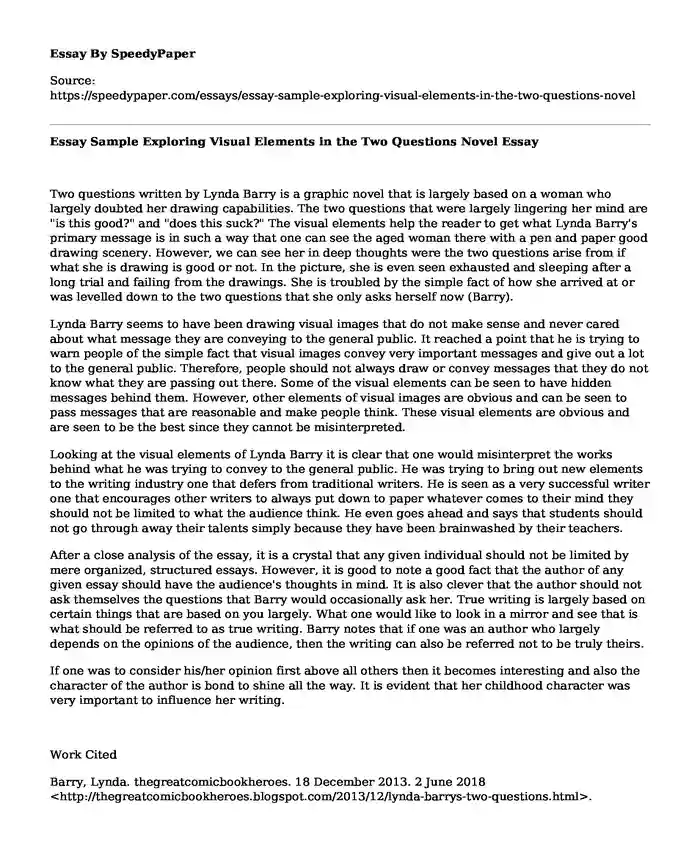
| Type of paper: | Essay |
| Categories: | Literature Art |
| Pages: | 3 |
| Wordcount: | 568 words |
Two questions written by Lynda Barry is a graphic novel that is largely based on a woman who largely doubted her drawing capabilities. The two questions that were largely lingering her mind are "is this good?" and "does this suck?" The visual elements help the reader to get what Lynda Barry's primary message is in such a way that one can see the aged woman there with a pen and paper good drawing scenery. However, we can see her in deep thoughts were the two questions arise from if what she is drawing is good or not. In the picture, she is even seen exhausted and sleeping after a long trial and failing from the drawings. She is troubled by the simple fact of how she arrived at or was levelled down to the two questions that she only asks herself now (Barry).
Lynda Barry seems to have been drawing visual images that do not make sense and never cared about what message they are conveying to the general public. It reached a point that he is trying to warn people of the simple fact that visual images convey very important messages and give out a lot to the general public. Therefore, people should not always draw or convey messages that they do not know what they are passing out there. Some of the visual elements can be seen to have hidden messages behind them. However, other elements of visual images are obvious and can be seen to pass messages that are reasonable and make people think. These visual elements are obvious and are seen to be the best since they cannot be misinterpreted.
Looking at the visual elements of Lynda Barry it is clear that one would misinterpret the works behind what he was trying to convey to the general public. He was trying to bring out new elements to the writing industry one that defers from traditional writers. He is seen as a very successful writer one that encourages other writers to always put down to paper whatever comes to their mind they should not be limited to what the audience think. He even goes ahead and says that students should not go through away their talents simply because they have been brainwashed by their teachers.
After a close analysis of the essay, it is a crystal that any given individual should not be limited by mere organized, structured essays. However, it is good to note a good fact that the author of any given essay should have the audience's thoughts in mind. It is also clever that the author should not ask themselves the questions that Barry would occasionally ask her. True writing is largely based on certain things that are based on you largely. What one would like to look in a mirror and see that is what should be referred to as true writing. Barry notes that if one was an author who largely depends on the opinions of the audience, then the writing can also be referred not to be truly theirs.
If one was to consider his/her opinion first above all others then it becomes interesting and also the character of the author is bond to shine all the way. It is evident that her childhood character was very important to influence her writing.
Work Cited
Barry, Lynda. thegreatcomicbookheroes. 18 December 2013. 2 June 2018 <http://thegreatcomicbookheroes.blogspot.com/2013/12/lynda-barrys-two-questions.html>.
Cite this page
Essay Sample Exploring Visual Elements in the Two Questions Novel. (2022, Jun 10). Retrieved from https://speedypaper.net/essays/essay-sample-exploring-visual-elements-in-the-two-questions-novel
Request Removal
If you are the original author of this essay and no longer wish to have it published on the SpeedyPaper website, please click below to request its removal:
- Free Essay Example on Values and Culture
- Essay Example on Vector Summation
- Ethical Issues of Artificial Intelligence in this Ready-to-Download Free Essay
- Free Essay Example: Design and Build a Route
- Annotated Bibliography Entries on Education Programs. Essay Example
- Why Should Educated People Understand the Geography of Folk and Popular Culture? - Essay Sample
- Essay Example: Equity Investment Management
Popular categories




